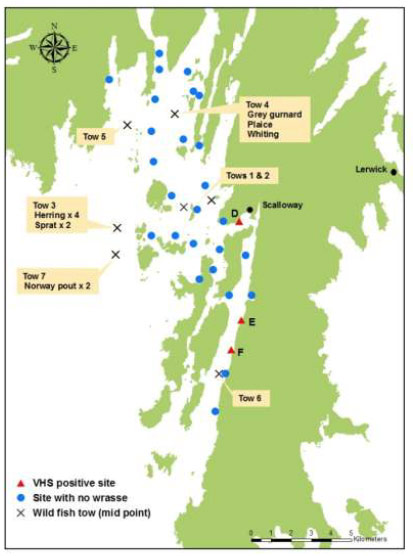Scottish Marine and Freshwater Science Volume 4 Number 3: Epidemiology and Control of an Outbreak of Viral Haemorrhagic Septicaemia in Wrasse Around Shetland Commencing 2012
Report on an outbreak of viral haemorrhagic septicaemia in multiple stocked species of wrasse on six sea-water sites around Shetland Mainland commencing December 2012.
9 Tests for VHS in Other Species
9.1 Atlantic Salmon on Farms
Five of the six VHS positive sites were Atlantic salmon farms. Atlantic salmon from each of these were tested for VHS even though the species is not listed as susceptible under EC Council Directive 2006/88/ EC. This was done to check that the VHSV strain infecting wrasse had not become adapted to Atlantic salmon.
A total of 750 Atlantic salmon, consisting of 150 from each VHS positive farm, were individually tested using virus isolation with ELISA confirmation. This sample size is associated with a 95% chance of detecting at least one VHS positive individual at an apparent prevalence of 0.4%. All 750 individuals tested negative.
9.2 Gadoids Within Farm Pens
Wild gadoids were observed amongst Atlantic salmon in farm pens and some of the species are listed as susceptible under EC Council Directive 2006/88/ EC.
A total of 63 gadoids, comprising 58 poor cod ( Trisopterus minutus), four whiting and one saithe ( Pollachius virens) representing all the populations of one VHS positive farm, were individually tested using virus isolation with ELISA confirmation. Two poor cod tested VHS positive. The apparent prevalence of VHS positive poor cod is three percent with a 95% CI of less than (<) one to 70% [32] .
9.3 Lumpsucker at First-reported Site
A population of hatchery-reared lumpsucker supplied from Norway during November and December 2012 were held in the same room as the VHS positive wrasse at the first-reported site. The lumpsucker were screened for VHS even though the species is not listed as susceptible under EC Council Directive 2006/88/ EC. This was done because the lumpsucker were being held prior to deployment for an on-farm evaluation of their utility as a biological control for sea-lice and if infected could have represented a threat to the health of other aquatic animals.
A total of 630 lumpsucker were individually screened using qRT-PCR. This sample size is associated with a 95% chance of detecting at least one VHS positive individual at an apparent prevalence of 0.5%. All 630 individuals tested negative.
9.4 Free-ranging Wild Fish
Free-ranging marine fish were captured by demersal trawling around south-west Shetland mainland during April 2013. This locality was selected because it included the first-reported site and two of the VHS positive farms. Seven tows around the locality were carried out over four days (Figure 3). Tissue samples from 1400 individuals were taken and grouped into 140 testing pools, each containing 10 individuals of the same species. The number of pools for each species were in approximate proportion to the species composition of individual tows. Further details of the sampling procedure are provided in Appendix 2.
Figure 3. Location of wild fish sampling tows and VHS positive pools

A total of 11 pools of grey gurnard ( Eutrigla gurnardus), herring ( Clupea harengus), Norway pout ( Trisopterus esmarkii), plaice ( Pleuronectes platessa), sprat ( Sprattus sprattus), and whiting were VHS positive by virus isolation with ELISA confirmation (Table 3).
Table 3. Summary of VHS test results on pools of free-ranging wild fish
| Species α | Test Result β |
|---|---|
| Norway pout ( Trisopterus esmarkii) | 2/4 |
| sprat ( Sprattus sprattus) | 2/5 |
| grey gurnard ( Eutrigla gurnardus) | 1/3 |
| herring ( Clupea harengus) | 4/22 |
| whiting ( Merlangius merlangus) | 1/24 |
| plaice ( Pleuronectes platessa) | 1/40 |
| common dab ( Limanda limanda) | 0/21 |
| long-rough dab ( Hippoglossoides platessoides) | 0/5 |
| haddock ( Melanogrammus aeglefinus) | 0/4 |
| lemon sole ( Microstomus kitt) | 0/4 |
| Atlantic cod ( Gadus morhua) | 0/3 |
α in addition one VHS negative pool for each of flounder ( Platichthys flesus), mackerel ( Scomber scombrus), pogge ( Agonus cataphractus), saithe and short-horn sculpin ( Myoxocephalus scorpius) were obtained but are not included in the body of the table;
β number positive/number pools tested using virus isolation with ELISA confirmation.
Eight percent of pools were VHS positive with 95% CI of four to 14%. This estimate is not a prevalence because the number of VHSV infected individuals within each pool is unknown. There is no evidence of a clustering of VHS positive pools by species or location of tow [33] although the statistical power of this comparison is likely to be low.
Contact
There is a problem
Thanks for your feedback